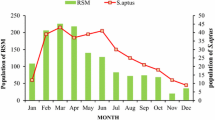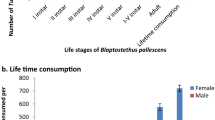Abstract
Field observations were made to find out seasonal abundance of Eocanthecona furcellata (Wolff) (Hemiptera: Pentatomidae) a predatory bug of an invasive pest, the black inch worm, Hyposidra talaca Walker (Lepidoptera: Geometridae) in tea ecosystem. The trend of population study revealed that E. furcellata was abundant throughout the cropping period, with peaks during June to September. Investigations were also carried out on the biology and predatory efficiency of E. furcellata on the larvae of H. talaca. The fecundity of the predatory bug was recorded as 276.6 ± 15.8 eggs/female. The incubation period was 7.0 ± 1.0 days, total nymphal development period 21.8 ± 0.7 days and adult longevity was 30.8 ± 1.9 days. Construction of life table of E. furcellata by rearing the tea looper H. talaca indicated that, the life table parameters like, intrinsic rate of natural increase (rm) was 0.149, net reproductive rate (Ro) was 218.14 eggs/female, gross reproduction rate (∑mx) was 244.69, generation time (T) 35.49 d, doubling time (DT) 4.63 d and finite rate of increase (λ) was 1.161. The adult female consumed 10.2 ± 0.8 s instar looper in ‘no-choice’ condition, whereas in ‘free- choice’ condition the consumption was 9.8 ± 1.1 second instar and 5.4 ± 1.1 fifth instar larvae of H. talaca per day. The impact of commonly used pesticides on the predator indicated varying degree of mortality on nymphs and adults after 24 h of exposure. Hence, E. furcellata could effectively be utilized in the IPM programme envisaged for tea for effective management of H. talaca.


Similar content being viewed by others
References
Amor, F., Medina, P., Bengochea, P., Cánovas, M., Vega, P., Correia, R., García, F., Gómez, M., Budia, F., Viñuela, E., & López, J. A. (2012). Effect of Emamectin benzoate under semi-field and field conditions on key predatory biological control agents used in vegetable greenhouses. Biocontrol Science and Technology, 22(2), 219–232.
Andrewartha, H. G., & Birch, L. C. (1954). The distribution and abundance of animals. Chicago: University of Chicago Press.
Antony, B., Sinu, P. A., & Rehman, A. (2012). Looper caterpillar invasion in north east Indian tea agro-ecosystem, change of weather and habitat loss may be possible causes? Journal of Tea Science Research, 2, 1–5.
Barua, A., Babu, A., & Rajkhowa, R. C. (2016). Seasonal abundance and predatory potential of Stethorus aptus Kapur (Coleoptera, Coccinellidae), a biocontrol agent of tea red spider mite Oligonychus coffeae Nietner (Acarina, Tetranychidae). Preceding of the Zoological Society, 71(3), 224–228.
Bhatnagar, V. R., Maurya, R. P., Brijwal, L., Dobhal, P., Suyal, P., & Singh, N. K. (2019). Study on variability among predatory stink bug, Eocanthecona furcellata (Wolff) (Hemiptera, Pentatomidae) population thriving in different agro-ecosystems of North-Western Himalayas, India. Journal of Entomology and Zoology Studies, 7(3), 726–736.
Brich, L. C. (1948). The intrinsic rate of natural increase of an insect population. Journal of Animal Ecology, 17, 15–26.
Chakravarty, S., Agnihotri, M., & Jagdish, J. (2017). Seasonal abundance of predatory bugs, Eocanthecona furcellata (Wolff.) and Rhynocoris fuscipes (F.) and its olfactory responses towards plant and pest mediated semiochemical cues in Pigeonpea ecosystem. Legume Research, 40(2), 351–357.
Cloyd, R. A., Timmons, N. R., Goebel, J. M., & Kemp, K. E. (2009). Effect of pesticides on adult rove beetle Atheta coriaria (Coleoptera, Staphylinidae) survival in growing medium. Journal of Economic Entomology, 102(5), 1750–1758.
Croft, B. A. (1990). Arthropod biological control agents and pesticides. New York: Jhon Wiley and Sons.
Das, G. M. (1965). Pests of tea in north-East India and their control. Tocklai Experimental Station, Tea Research Association, Jorhat, Assam, India.
Das, S., & Mukhopadhyay, A. (2014). Host-based life cycle traits and detoxification enzymes of major looper pests (Lepidoptera, Geometridae) of tea from Darjeeling Terai, India. Phytoparasitica, 42, 275–283.
Das, S., Roy, S., & Mukhopadhyay, A. (2010). Diversity of arthropod natural enemies in the tea plantations of North Bengal with emphasis on their association with tea pests. Current Science, 99(10), 1457–1463.
Deevy, E. S. (1947). Life table for natural populations of animals. The Quarterly Review of Biology, 22, 283–314.
Delbeke, F., Vercruysse, P., Tirry, L., Clercq, D. P., & Degheele, D. (1997). Toxicity of Diflubenzuron, Pyriproxifen, Imidacloprid and Diafenthiuron to the predatory bug Oriuslae vigatus (Het., Anthocoridae). Entomophaga, 42(3), 349–358.
Dent, D., & Walton, M. P. (1997). Methods in ecological and agricultural entomology. In Wallingford, Oxon, UK. New York: CAB International.
Ganguli, J., Chandrakar, S., & Puri, C. (2000). Canthecona furcellata Wel., a predatory bug on caterpillars of Clostera sp. Insect Environment, 6(2), 79–80.
Gillespie, D. R., Opit, G., & Roitberg, B. (2000). Effects of temperature and relative humidity on development, reproduction and predation in Feltiella acarisuga (Vallot) (Diptera, Cecidomyiidae). Biological Control, 17, 132–138.
Jervis, M. A., & Copland, M. J. W. (1996). The life cycle. In M. Jervis & B. Kidd (Eds.), Insect natural enemies; practical approaches to their study and evaluation (pp. 6–161). London: Chapman and Hall.
Kalaiyarasi, L., Livingstone, A. R., & Miracline, S. F. (2017). A report on the predatory behaviour of stink bug Eocanthecona furcellata Wolff (Hemiptera, Pentatomidae) on the eggs and grubs of Henosepilachna vigintioctopunctata. International Journal of Recent Science Research, 8(8), 19550–19554.
Kumar, V., Morrison, M. N., Rajadurai, S., Babu, A. M., Thiangarajan, V., & Datta, R. K. (2001). Studies on the biology and predatory behaviour of Eocanthecona furcellata (Wolff.) predating on Spilaricta oblique (walk.) in mulberry plantation. International Journal of Industrial Entomology, 2(2), 173–180.
Lenin, E. A., & Rajan, S. J. (2016). Biology of predatory bug Eocanthecona furcellata Wolff (Hemiptera, Pentatomidae) on Corcyra cephalonica Stainton. Journal of Entomology and Zoology Studies, 4(3), 338–340.
Mackauer, M. (1983). Quantitative assessment of Aphidius smithi (Hymenoptera, Aphidiidae), fecundity, intrinsic rate of increase and functional response. Canadian Entomologist, 115, 399–415.
Mobed, K., Gold, E. B., & Schenker, M. B. (1992). Occupational health problems among migrant and seasonal farm workers. The Western Journal of Medicine, 157, 367–373.
Muraleedharan, N., & Selvasundaram, R. (1995). Natural enemies of tea pests. In, Ecofriendly Tea Farming- Planters’ Alternative Approach, pp22–28). UPASI – KVK, Coonoor, Nilgiris.
Nguyen, T. T., Suryamohan, K., Kuriakose, B., Janakiraman, V., Reichelt, M., Chaudhuri, S., Guillory, J., Divakaran, N., Rabins, P. E., Goel, R., Deka, B., Sarkar, S., Ekka, P., Tsai, Y. C., Vargas, D., Santhosh, S., Mohan, S., Chin, C. S., Korlach, J., Thomas, G., Babu, A., & Seshagiri, S. (2018). Comprehensive analysis of single molecule sequencing-derived complete genome and whole transcriptome of Hyposidra talaca nuclear polyhedrosis virus. Scientific Reports, 8, 8924.
Nielsen, A. L., Hamilton, G. C., & Matadha, D. (2008). Developmental rate estimation and life table analysis for Halyomorpha halys (Hemiptera, Pentatomidae). Environmental Entomology, 37(2), 348–355.
Nyunt, K. T. (2008). Potential of the predatory pentatomid Eocanthecona furcellata (Wolff) as a bio-control agent on American bollworm in cotton in Myanmar. Ph.D. Thesis, Georg-August University Göttingen, Germany.
Pillai, K. A., & Agnihotri, M. (2011). Population dynamics of the predatory bug Eocanthecona furcellata (Wolff.). Indian Journal of Applied Entomology, 25, 162–163.
Prasad, A. K., & Mukhopadhyay, A. (2013). A technique to measure the loss in tea crop by the defoliating pest (Hyposidra talaca Walker) on the basis of dry mass and leaf area parameters. International journal of Bio-resource and Stress Management, 4(2s), 358–361.
Puja, D., & Sabiha, K. (2016). A field study of population dynamics of major insect pests and their natural enemies on cauliflower of Ajmer district. International Journal of Agriculture Sciences, 8(53), 2642–2645.
Ray, S. N., & Khan, M. A. (2011). Biology of predatory bug, Canthecona furcellata Wolff. (Hemiptera, Pentatomidae) on poplar defoliator, Clostera fulgurita Walker (Lepidoptera, Notodontidae). Journal of Biopesticides, 4(2), 109–111.
Roy, M., Brodeur, J., & Cloutier, C. (2003). Effect of temperature on intrinsic rates of natural increase (rm) of a coccinellid and its spider mite prey. Bio-control, 48, 57–72.
Roy, S., Das, S., Handique, G., Mukhopadhyay, A., & Muraleedharan, N. (2017). Ecology and management of the black inch worm, Hyposidra talaca Walker (Geometridae, Lepidoptera) infesting Camellia sinensis (Theaceae), a review. Journal of Integrative Agriculture, 16(10), 2115–2127.
Roy, S., Muraleedharan, N., & Pujari, D. (2014). Acatalogue of arthropod pests and their natural enemies in the tea ecosystem of India. Two and a Bud, 61(1&2), 11–39.
Sabelis, M. W. (1992). Predatory arthropods. In M. J. Crawley (Ed.), Natural enemies. The population biology of predators, parasites and disease (pp. 22–264). Oxford: Blackwell.
Sarkar, S., Babu, A., Chakraborty, K., & Deka, B. (2019). Study on the biology, feeding behaviour and predatory potential of Sycanus collaris (Fabricius) (Heteroptera, Reduviidae), a new predator of Hyposidra talaca (walk.) (Lepidoptera, Geometridae), a major tea pest and mass rearing on Corcyra cephalonica (Stainton) in laboratory. International Journal of Current Advanced Research, 08(06), 19258–19262.
Siddaiah, A. A., & Devi, A. R. (2015). Biology of a predatory bug Eocanthecona furcellata Wolff (Hemiptera, Pentatomidae) on Vapourer tussock moth larvae, a major pest of tasar silkworm food plants. International Journal of Industrial Entomology, 30(1), 26–30.
Sinu, P. A., Antony, B., & Mallick, S. (2011). The occurrence of nucleopolyhedrovirus infecting Hyposidra talaca (Geometridae, Lepidoptera), a tea defoliator from north- East India. Biocontrol Science and Technology, 21, 999–1003.
Southwood, T. R. E. (1978). The construction, description and analysis of age- specific life-tables. In T. R. E. Southwood (Ed.), Ecological methods with particular reference to the study of insect population (pp. 356–387). London: Champ and Hall.
Southwood, T. R. E., & Henderson, P. A. (2000). Ecological methods 3rd edition. Backwell.
Suyal, P., Gaur, N., Rukesh, P. K. N., & Devrani, A. (2018). Seasonal incidence of insect pests and their natural enemies on soybean crop. Search Results Journal of Entomology and Zoology Studies, 6(4), 1237–1240.
Thungrabeab, M., & Tongma, S. (2007). Effect of entomopathogenic fungi, Beauveria bassiana (balsam) and Metarhizium anisopliae (Metsch) on non-target insects. Science and Technology Journal, 7(1), 8–12.
Tiwari, S., Mayuri, R. P., & Pandey, A. K. (2017). Effect of different insect hosts on biology and predation efficiency of Eocanthecona furcellata Wolff (Hemiptera, Pentatomidae). The bioscan, 12(1), 193–197.
Tuan, S. J., Yeh, C. C., Atlihan, R., & Chi, H. (2015). Linking life table and predation rate for biological control, a comparative study of Eocanthecona furcellata (Hemiptera, Pentatomidae) fed on Spodoptera litura (Lepidoptera, Noctuidae) and Plutella xylostella (Lepidoptera, Plutellidae). Journal of Economic Entomology, 1–13, 1–12.
Vasanthkumar, D., Roobakkumar, A., Rahaman, V. K. J., & Babu, A. (2011). Impact of temperature and pesticide applications on the prey consumption of Mallada desjardins (Navas) (Neuroptera, Chrysopidae), a predator of red spider mite infesting tea. Two and a Bud, 59, 43–48.
Veire, V. D. M., Sterk, G., Staaij, V. D. M., Ramakers, P. M. J., & Tirry, L. (2002). Sequential testing scheme for the assessment of the side-effects of plant protection products on the predatory bug Oriuslae vigatus. BioControl, 47, 101–113.
Yasuda, T. (2000). Role of semiochemicals in prey- locating behavior of a generalist predatory stink bug Eocanthecona furcellata (Heteroptera, Pentatomidae). Japan Agricultural Research Quarterly, 34, 15–20.
Yasuda, T., & Wakamura, S. (1992). Rearing of the predatory stink bug, Eocanthecona furcellata (Wolff) (Heteroptera: Pentatomidae), on frozen larvae of Spodoptera litura (Fabricius) (Lepidoptera: Noctuidae). Applied Entomology and Zoology, 27(2), 303–305.
Zanuncio, J. C., Mourão, S. A., Martínez, L. C., Carlos Frederico Wilcken, C. F., Ramalho, F. S., Rueda, A. P., Soares, M. A., & Serrão, J. E. (2016). Toxic effects of the neem oil (Azadirachta indica) formulation on the stink bug predator, Podisus nigrispinus (Heteroptera, Pentatomidae). Scientific Reports, 6, 30261.
Acknowledgments
Authors are thankful to the authority and the management team of Banarhat T.E. of Jalpaiguri district, West Bengal, India for supporting in field survey.
Author information
Authors and Affiliations
Corresponding author
Ethics declarations
Conflict of interest
The authors declare that they have no conflict of interest.
Additional information
Publisher’s note
Springer Nature remains neutral with regard to jurisdictional claims in published maps and institutional affiliations.
Rights and permissions
About this article
Cite this article
Sarkar, S., Babu, A., Chakraborty, K. et al. Eocanthecona furcellata (Wolff) (Hemiptera: Pentatomidae), a potential biocontrol agent of the black inch worm, Hyposidra talaca Walker (Lepidoptera: Geometridae) infesting tea. Phytoparasitica 49, 363–376 (2021). https://doi.org/10.1007/s12600-021-00888-x
Received:
Accepted:
Published:
Issue Date:
DOI: https://doi.org/10.1007/s12600-021-00888-x




